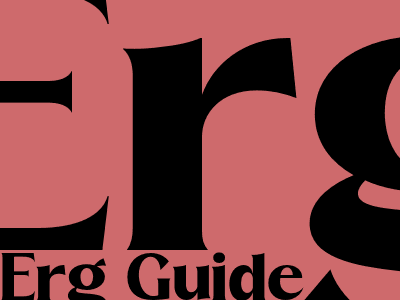
How to Use an Erg Guide: A Comprehensive Guide
Introduction
An erg guide is an essential tool for any fitness professional or athlete who wants to maximize their training efficiency and effectiveness. An ergometer, or "erg," is a device that measures the amount of work done during an exercise session. It provides valuable data such as power output, energy expenditure, and heart rate, helping users track their progress and identify areas for improvement. In this comprehensive guide, we will delve into the fundamentals of using an erg guide, including its benefits, features, and how to interpret the data it provides.
First of all, you may ask yourself - what is it like to use an Erg Guide?
Benefits of Using an Erg Guide
1. Track Progress
An erg guide allows users to accurately track their progress over time. It provides objective data that can be used to set goals, monitor improvements, and make informed decisions about training programs.
2. Measure Energy Expenditure
Ergs accurately measure the amount of energy expended during exercise, providing valuable insights into calorie burn. This information is crucial for weight management, fitness goals, and optimizing nutrition.
3. Identify Training Zones
Ergs help users identify their optimal training zones based on heart rate, power output, and other metrics. This allows for targeted training that maximizes results while minimizing the risk of injury.
4. Enhance Motivation
Monitoring progress and seeing tangible results can be highly motivating. An erg guide provides a sense of accountability and encourages users to stay on track with their fitness goals.
5. Improve Technique
Ergs provide real-time feedback on exercise form, allowing users to identify and correct improper technique. This can lead to improved efficiency and reduced risk of injury.
Features of an Erg Guide
Erg guides vary in features, but most commonly include the following:
- Power Output: Measures the amount of force applied and the rate at which work is done.
- Energy Expenditure: Calculates the number of calories burned during exercise.
- Heart Rate Monitoring: Tracks heart rate to determine training intensity and recovery status.
- Display: Provides a clear and easy-to-read display of data, often with customizable options.
- Connectivity: Some ergs offer wireless connectivity to fitness apps and devices for data tracking and analysis.
How to Interpret Erg Guide Data
Interpreting erg guide data is essential for optimizing training. Here's how to understand the key metrics:
1. Power Output
Power output is measured in watts and indicates the rate at which work is being done. Higher power output typically corresponds to greater fitness levels and training intensity.
2. Energy Expenditure
Energy expenditure is measured in calories and represents the amount of energy burned during exercise. This information can help users set calorie goals and track progress towards weight loss or maintenance.
3. Heart Rate
Heart rate is a measure of cardiovascular fitness and training intensity. It helps users stay within their target heart rate zones for optimal results.
Tips for Using an Erg Guide Effectively
To get the most out of an erg guide, follow these tips:
- Calibrate Regularly: Ensure accurate readings by calibrating your erg guide according to the manufacturer's instructions.
- Set Realistic Goals: Use erg guide data to set achievable goals based on your current fitness level and progress.
- Monitor Trends: Observe long-term data trends to identify patterns and make adjustments to training programs as needed.
- Consider Other Factors: Recognize that erg guide data is just one part of a comprehensive fitness assessment. Consider factors such as sleep, nutrition, and stress levels when evaluating progress.
- Consult a Professional: For personalized guidance and interpretation of erg guide data, consult with a qualified fitness professional or sports medicine physician.
Conclusion
An erg guide is a powerful tool that empowers fitness professionals and athletes to optimize their training. By providing accurate data on power output, energy expenditure, and heart rate, it enables users to track progress, identify training zones, enhance technique, and stay motivated. Remember, using an erg guide effectively requires proper calibration, goal setting, and interpretation of data. With the right approach, an erg guide can be an invaluable asset in achieving fitness goals and enhancing overall performance.